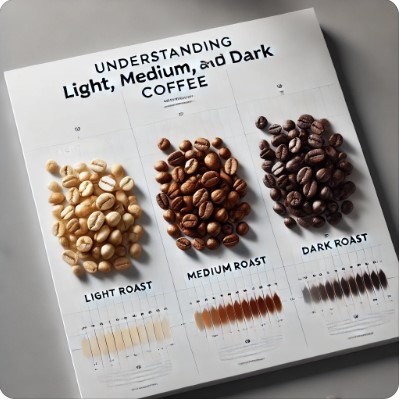
Light, Medium, or Dark? How Coffee Bean Roasting Influences Your Cup
Crafting the Perfect Roast: Understanding How Roasting Levels Impact Colour and Flavor
Coffee bean roasting is much more than simply heating raw beans; it is a precise and intricate process that significantly influences the final aroma, flavor, and even color of your brew. From the delicate acidity of lightly roasted beans to the bold intensity of dark roasts, every roasting stage transforms the coffee’s characteristics. This article explores how different roasting levels impact the aroma and color of coffee beans, helping you appreciate the science and artistry behind your daily cup.

Coffee Bean Roasting
Understanding Coffee Bean Roasting Levels
Before delving into the effects of roasting, it’s crucial to understand how coffee beans transform during the roasting process. As heat is applied, the beans undergo various chemical and physical changes, losing moisture and expanding in size.
The Coffee Bean Roasting Process: From Raw Bean to Aromatic Brew
Coffee beans undergo several stages during roasting. As moisture evaporates, the beans transition from green to yellow before reaching the first crack. This audible crack signals that the beans have matured. If roasting continues beyond the first crack, the beans enter the second crack stage, resulting in deeper caramelization and a darker roast.
Since there is no universal standard for roasting levels, perceptions of what constitutes light, medium, or dark roasting can vary. To reduce inconsistencies, the Specialty Coffee Association of America (SCAA) uses infrared caramelization measurement technology to assess bean color and classify roasting levels.
Roasting levels are often divided into eight categories, with lighter roasts having higher numeric values and darker roasts having lower values. However, in practical settings, visual assessment alone can be misleading due to varying sugar content in coffee bean skins. Instead, roasters rely on a combination of bean color, aroma, and texture to determine the roasting level, generally classified into three broad categories: light, medium, and dark roast.
3 Coffee Bean Roasting Levels
The coffee bean roasting process can be broadly categorized into three main roasting levels:
1. Light Roast: Bright and Complex
Lightly roasted beans are typically removed from the heat just after the “first crack”—a stage where internal gases cause the beans to expand and crack audibly. These beans retain much of their original acidity and exhibit complex, floral, and fruity notes. Because they are roasted for a shorter period, their color remains light brown, and their surface is dry due to minimal oil migration.
Aroma & Flavor: Light roasts highlight the unique terroir of the coffee, emphasizing citrus, berry, and floral aromas. For example, a lightly roasted Ethiopian Yirgacheffe may reveal bright lemon zest and delicate jasmine notes.
Color & Texture: The beans appear pale brown with a matte surface, as the oils have not yet emerged. They are denser and harder compared to darker roasts.
2. Medium Roast: Balanced and Sweet
Medium roasted beans are roasted beyond the first crack but pulled before the second crack begins. This level strikes a balance between acidity and sweetness, as the sugars within the beans undergo caramelization, enhancing the body and depth of flavor.
Aroma & Flavor: Medium roasts offer a well-rounded cup with a harmonious blend of acidity, sweetness, and bitterness. Expect notes of caramel, chocolate, and mild fruitiness. A Colombian medium roast, for instance, may exhibit a balanced profile of sweet cocoa and subtle nutty undertones.
Color & Texture: The beans take on a richer brown hue, and while still dry, they may show a slight sheen of oils as the roasting process progresses.
3. Dark Roast: Bold and Intense
Dark roasts are taken past the second crack, leading to significant caramelization and a reduction in acidity. The oils inside the beans migrate to the surface, resulting in a glossy, dark brown to nearly black appearance.
Aroma & Flavor: These beans develop a dominant roasted aroma, often with smoky, bitter, and chocolatey characteristics. The nuanced fruit and floral notes of the original bean give way to bold flavors of molasses, toasted nuts, and even charred undertones. A dark-roasted Sumatra Mandheling, for example, will present deep, earthy flavors with a lingering bittersweet finish.
Color & Texture: The beans appear shiny due to the emergence of natural oils, and their density is significantly reduced, making them more brittle and easier to grind.
The Science Behind Roasting: Aroma and Chemical Reactions
Two critical chemical processes shape the aroma and flavor of coffee during roasting:
- Maillard Reaction: This reaction occurs as amino acids and reducing sugars interact under heat, creating a range of complex aroma compounds. It is responsible for the development of nutty, caramel, and toasted notes, contributing to the overall depth of the coffee’s flavor profile.
- Caramelization: As temperatures rise, the natural sugars in coffee break down further, intensifying the sweetness and bitterness. This process plays a pivotal role in medium and dark roasts, leading to richer, chocolate-like flavors.
Conclusion: Choosing the Right Roast for Your Taste
Understanding how roasting influences aroma and color empowers you to choose the right coffee to suit your taste. If you enjoy bright, citrusy flavors, a light roast may be ideal. If you prefer a smooth, well-balanced cup, opt for a medium roast. For those who crave bold, smoky intensity, a dark roast will deliver the robust experience you seek.
Whether you are a coffee enthusiast or a casual drinker, exploring different roasting levels can elevate your appreciation for the craft of coffee roasting. Next time you take a sip, take a moment to consider the journey of the bean—from green and raw to aromatic and flavorful—shaped by the hands of expert roasters.


No Comments